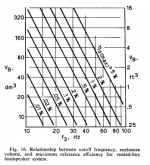GM you are so smart and experienced that I did not understand what it means what you wrote in this postJL Audio 13W7-D1.5 end loaded ~23.5 Hz (driver Fs) 1/4 WL pipe 1:1 CR (blue)/335 cm axial length Vs 2:1 CR (red)/335 cm/0.707 = 473.8 cm comparison, so a bit more than 'one note' 😉, and if a 0.5:1 CR, then it fills in the rolled off response to (Fs).
however I think we are getting closer to the solution, the ideas are there, the only problem is the size, but we will solve everything
Bass reflex don't require large size to tune low, but to tune low and loud in a small size does requires large, long ducts, which will increase volume far beyond your target size.wow the data are perfect, I already knew the bass reflex but I was afraid of the large size, I am interested in that it is as big as a 40-45 liter travel suitcase. if the dimensions coincide or poosomally get to those of a suitcase then I choose the bass reflex
The maximum VLF output in a 45 liter suitcase size will be achieved with very high power, high excursion drivers and passive radiators tuned to the lowest frequency desired.
Tom Danley's Contra Bass subwoofer was an example of that technology from last century, though his servodrive woofer's excursion potential was far less (only 19mm peak to peak) than those available shortly after, less than half that of Bob Carver's Sunfire subwoofer.
A doubling of excursion provides +6dB output, down in the <20Hz range, equivalent to more than "twice as loud".
Art
Attachments
I wish! 'Smart': "having or showing a quick-witted intelligence"; there's too much proof to the contrary in my life, but over many decades have accumulated an above average amount knowledge about sound reproduction.GM you are so smart and experienced that I did not understand what it means what you wrote in this post
Regardless, it was a response to lcsaszar's assertion, cracked case's query.
'Suitcase' size, not a chance in this reality. Attached is the acoustical limits of various vented box sizes. 82 dB = 0.01%, so 80 dB is even lower. I've lost the math, but hopefully someone else will post it to calculate the 80 dB/10 Hz % eff., minimum box volume.yes yes gm I am aware of the high dimensions, but my use will be 1 meter away so I believe that solutions can be found
Attachments
Forgot to mention the 0.5:1 CR = ~464.31 L, 1:1/~232.16 L, 2:1/~116.08 LJL Audio 13W7-D1.5 end loaded ~23.5 Hz (driver Fs) 1/4 WL pipe 1:1 CR (blue)/335 cm axial length Vs 2:1 CR (red)/335 cm/0.707 = 473.8 cm comparison, so a bit more than 'one note' 😉, and if a 0.5:1 CR, then it fills in the rolled off response to (Fs).
so let's do one thing, for the bass reflex the maximum dimensions must be: height = 70 cm, depth = 40 cm and width = 45 cm. so from these dimensions I would like to build a bass reflex, so the frequencies, now do not matter much, but it is important for me to respect the dimensions, so any frequency (as long as infrasonic) is fine. obviously we take all the necessary precautions, high power drivers, passive radiators etc. to get the best result, so please send me the assembly instructions respecting those dimensions I wrote before, in order to immediately build the bass reflex, thanks friendsBass reflex don't require large size to tune low, but to tune low and loud in a small size does requires large, long ducts, which will increase volume far beyond your target size.
The maximum VLF output in a 45 liter suitcase size will be achieved with very high power, high excursion drivers and passive radiators tuned to the lowest frequency desired.
Tom Danley's Contra Bass subwoofer was an example of that technology from last century, though his servodrive woofer's excursion potential was far less (only 19mm peak to peak) than those available shortly after, less than half that of Bob Carver's Sunfire subwoofer.
A doubling of excursion provides +6dB output, down in the <20Hz range, equivalent to more than "twice as loud".
Art
hi GM I had found formulas on the internet that told me that for a brass organ pipe with a length of 17 meters and a CSA of 37 cm I can get an SPL greater than 80 Db, so I think it is feasible, I want build both the bass reflex and also the tube, the dimensions are those written in my previous post and are also valid for the suitcase that must contain the tube, so I will build two suitcases, one that contains the bass reflex and one for the tube. so what should be the length and width of the tube, and with which drivers should I push the internal air? would a compressor be better?Forgot to mention the 0.5:1 CR = ~464.31 L, 1:1/~232.16 L, 2:1/~116.08 L
A box of those exterior dimensions would work well for a Stereo Integrity HST-18, sealed.so let's do one thing, for the bass reflex the maximum dimensions must be: height = 70 cm, depth = 40 cm and width = 45 cm. obviously we take all the necessary precautions, high power drivers, passive radiators etc. to get the best result, so please send me the assembly instructions respecting those dimensions I wrote before, in order to immediately build the bass reflex, thanks friends.
You could expect near 97dB at 8Hz, 109 dB at 16 Hz at one meter at your feet.
Assembly instructions: Use 19mm Baltic Birch plywood, brace the interior similar to this:
Forget the pipe dreams, go for displacement!
Art
Looks like one note and harmonics, so one note. How many notes does a single pipe of a pipe organ play?JL Audio 13W7-D1.5 end loaded ~23.5 Hz (driver Fs) 1/4 WL pipe 1:1 CR (blue)/335 cm axial length Vs 2:1 CR (red)/335 cm/0.707 = 473.8 cm comparison, so a bit more than 'one note' 😉, and if a 0.5:1 CR, then it fills in the rolled off response to (Fs).
WOW! Wasn't aware of this monster! 😱 Definitely 'no replacement for displacement'!
100 L hits 80 dB/10 Hz w/23 W, 2pi, so not much power required either, though still don't see the point of this low a frequency @ so far below audibility. I mean even 14 Hz at this SPL just rattles small, loose objects in my house and that's mostly because it's apparently its Fs.
100 L hits 80 dB/10 Hz w/23 W, 2pi, so not much power required either, though still don't see the point of this low a frequency @ so far below audibility. I mean even 14 Hz at this SPL just rattles small, loose objects in my house and that's mostly because it's apparently its Fs.
Obviously the box alignment is 'one note', but its BW is wide enough for multiples.Looks like one note and harmonics, so one note. How many notes does a single pipe of a pipe organ play?
The smaller ( in relation to it's length ) a pipe, the more pronounced the higher harmonics. That's why long organ pipes are also fat, the same principle is behind transmission lines having to be above a certain size. Shame you can't add density to the air in the pipe. I wonder what would happen if you put a passive radiator in an organ pipe. It's possible the wave would just bounce off.Looks like one note and harmonics, so one note. How many notes does a single pipe of a pipe organ play?
Last edited by a moderator:
sorry i didn't understand because of the translation, so the project you sent me can create 16hz, or as you wrote at the end, must i forget the pipe dreams? I did not understand what should I do?A box of those exterior dimensions would work well for a Stereo Integrity HST-18, sealed.
You could expect near 97dB at 8Hz, 109 dB at 16 Hz at one meter at your feet.
View attachment 1078805
Assembly instructions: Use 19mm Baltic Birch plywood, brace the interior similar to this:
View attachment 1078806
Forget the pipe dreams, go for displacement!
Art
yes yes this is the basis of the resonance principles studied by GavreauThe smaller ( in relation to it's length ) a pipe, the more pronounced the higher harmonics. That's why long organ pipes are also fat, the same principle is behind transmission lines having to be above a certain size. Shame you can't add density to the air in the pipe. I wonder what would happen if you put a passive radiator in an organ pipe. It's possible the wave would just bounce off.
so if I understand correctly with 100 liters can I do it? obviously I will insert very powerful drivers or compressorsWOW! Wasn't aware of this monster! 😱 Definitely 'no replacement for displacement'!
100 L hits 80 dB/10 Hz w/23 W, 2pi, so not much power required either, though still don't see the point of this low a frequency @ so far below audibility. I mean even 14 Hz at this SPL just rattles small, loose objects in my house and that's mostly because it's apparently its Fs.
he talked about air density, so what if instead of "air" we put carbon dioxide in the tube? it is denserThe smaller ( in relation to it's length ) a pipe, the more pronounced the higher harmonics. That's why long organ pipes are also fat, the same principle is behind transmission lines having to be above a certain size. Shame you can't add density to the air in the pipe. I wonder what would happen if you put a passive radiator in an organ pipe. It's possible the wave would just bounce off.
Each pipe plays a single note. The reason there are so many is because there may be 100 or more “ranks” playing when a single key is played. Each rank is like it’s own instrument in an orchestra so the more ranks, the more colors of sound. Playback of a 2 channel audio recording of the organ is one thing. Playback from a digital organ is a different animal because there are usually a minimum of 6 channels of output for the very smallest organ on a tight budget in a small space. Most are at least 12 audio channels and as many as the hardware can support. You get all kinds of comb filtering if too much organ is jammed through too few of channels, but infrasonic comb filtering is very hard to solve and will blow up equipment. For perspective, here is the amplifier rack for a massive digital organ at Amalie Arena in Tampa Florida, USA. I think it has 64 channels of audio and I think 16 of them are just for bass.Looks like one note and harmonics, so one note. How many notes does a single pipe of a pipe organ play?

- Home
- Loudspeakers
- Multi-Way
- Infrasonic pipe
